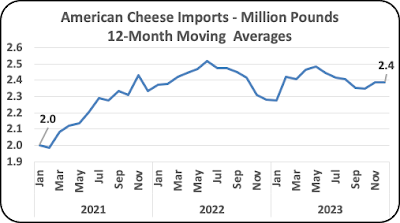The U.S. dairy industry is huge. Including producers, processors, and retailers, dairy is a very big business. In the end, the consumer satisfaction is key to success. This post will cover retail pricing trends and consumer purchases of the major dairy products, butter, cheddar cheese, and fluid milk. Fluid milk will be covered first as it has the largest price increases in the last five years.
Statistics for consumption of butter and cheddar cheese are not yet available for 2023. The data used to mimic domestic consumption is represented here by disappearance from wholesale inventories.
FLUID MILK
Fluid milk sales have been steadily falling. The rate of decline (Chart I) has been steady and continues to decline by about 2% annually. When COVID "stay at home" policies were implemented in early 2022 there was a short-term increase in fluid milk sales, likely caused by more cereal breakfasts. With the passage of "stay at home policies", the rate of decline resumed.
 |
| Chart I - U.S. Fluid Milk Retail Sales |
Its often said that milk, especially for children, is a necessity and sales will not decrease with increasing prices. The last five years has proven that correlation. Prices of milk hit a record high in December 2022 with a price of $4.21 per gallon. Since the beginning of 2019 to January 2024, the retail price of whole milk has increased by 36% (Chart II). This has caused some tight budgeting for young growing families, but purchases have remained their long-term trends. For the last year and a half, prices have leveled off at around $4.00 per gallon.
 |
| Chart II - Retail Prices of Whole Milk |
|
BUTTER
Butter prices have reached new record highs. Chart III follows the disappearance from wholesale inventories. They tell an interesting story. The year 2019 was normal with steady demand around 168 million pounds. During the COVID years demand for butter increased to around 175 million pounds. Then, in January 2023, the demand fell rapidly. What made this happen?
 |
Chart III - Butter Disappearance from
Wholesale Inventories.
In 2022 butter prices escalated causing buyers to go to optional products like margarine (Chart IV). The prices have since decreased a little and the volume of butter withdrawals from inventory have reached record volumes. This could partially be a catchup from when prices were higher. |
The real puzzle is that currently the butter prices have remained very high. Low inventories typically cause higher prices as covered in the prior post, but current butter inventories are not low.
 |
| Chart IV - Retail Butter Prices per Pound |
CHEESE
Cheese withdrawals from inventory are steadily growing (Chart V). There was some slowdown
during the :"stay at home" policies but following that period volume growth continued at about 2% annually, the long-term trend.
 |
Chart V - American Cheese Disappearance from
Wholesale Inventories
|
Wholesale cheddar cheese prices have followed demand as higher demand in late 2022 increased prices but with a slowdown in demand, the current price in January 2024 was at $5.72 per pound.
 |
| Chart VI - Retail price of Cheddar Cheese per Pound |
COMPARISON TO PRODUCER PRICES
Below are the producer prices for the milk used for fluid milk, butter, and cheese. The rate of inflation is for the last five years, the same as the retail prices above.
Comparing January 2019 to January 2024 there is a 28% increase in producer prices compared to the retail price increases of 36% for Fluid milk.
 |
| Chart VII - Class I Prices |
Class IV milk prices have gone up by 28% compared to the retail butter price increase of 15% over five years.
 |
| Chart VII - Class IV Prices |
Class III milk prices, the largest usage of producer milk, has gone up by 9%, almost identical to the retail price increase of cheese of 7% over five years.
 |
| Chart IX - Class III Milk Prices |
SUMMARY
Producer price increases of cheese closely parallel the retail price increases for cheese. However, fluid milk prices show a significant retail price increase well over the increase in producer milk prices. Is the necessary purchase allowing higher retail prices? Butter, which has a huge increase in producer prices reflects a much lower current price increase in retail sales. When retail butter prices went to a record high of $4.88 per pound, sales dropped. Did this cause retailers to lower prices? With lower retail prices, disappearance from inventories shot up which could cause even higher producer prices.
































